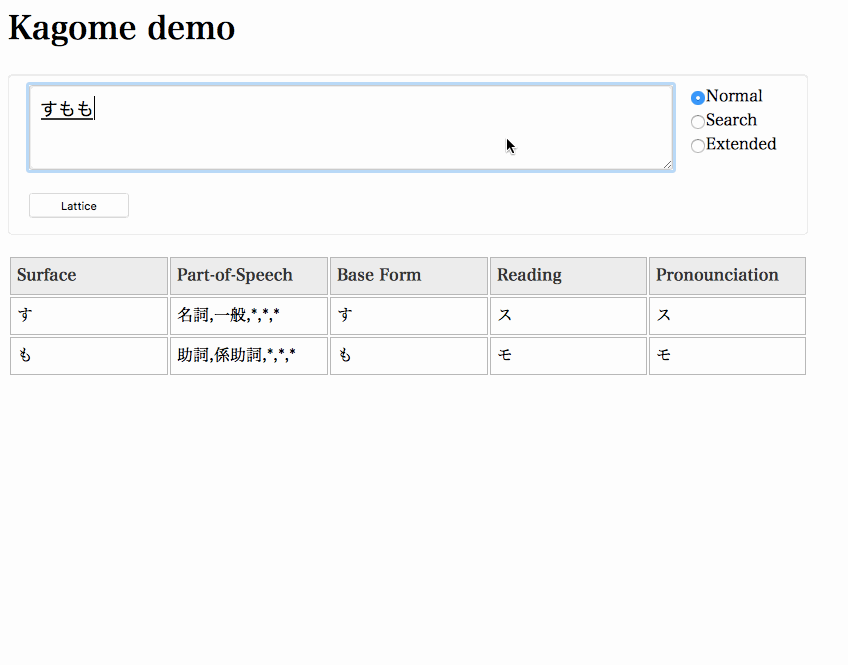Kagome is an open source Japanese morphological analyzer written in pure golang. The MeCab-IPADIC and UniDic (unidic-mecab) dictionary/statiscal models are packaged in Kagome binary.
% kagome
すもももももももものうち
すもも 名詞,一般,*,*,*,*,すもも,スモモ,スモモ
も 助詞,係助詞,*,*,*,*,も,モ,モ
もも 名詞,一般,*,*,*,*,もも,モモ,モモ
も 助詞,係助詞,*,*,*,*,も,モ,モ
もも 名詞,一般,*,*,*,*,もも,モモ,モモ
の 助詞,連体化,*,*,*,*,の,ノ,ノ
うち 名詞,非自立,副詞可能,*,*,*,うち,ウチ,ウチ
EOS
% go get -u github.com/ikawaha/kagome/...
$ kagome -h
Japanese Morphological Analyzer -- github.com/ikawaha/kagome
usage: kagome <command>
The commands are:
[tokenize] - command line tokenize (*default)
server - run tokenize server
lattice - lattice viewer
tokenize [-file input_file] [-dic dic_file] [-udic userdic_file] [-sysdic (ipa|uni)] [-mode (normal|search|extended)]
-dic string
dic
-file string
input file
-mode string
tokenize mode (normal|search|extended) (default "normal")
-sysdic string
system dic type (ipa|uni) (default "ipa")
-udic string
user dic
$ go run cmd/kagome/main.go -h
or
$ go run cmd/kagome/main.go tokenize -h
Usage of tokenize:
-dic string
dic
-file string
input file
-mode string
tokenize mode (normal|search|extended) (default "normal")
-sysdic string
system dic type (ipa|uni) (default "ipa")
-udic string
user dic
$ go run cmd/kagome/main.go server -h
Usage of server:
-http string
HTTP service address (default ":6060")
-sysdic string
system dic type (ipa|uni) (default "ipa")
-udic string
user dictionary
Kagome has segmentation mode for search such as Kuromoji.
- Normal: Regular segmentation
- Search: Use a heuristic to do additional segmentation useful for search
- Extended: Similar to search mode, but also unigram unknown words
| Untokenized | Normal | Search | Extended |
|---|---|---|---|
| 関西国際空港 | 関西国際空港 | 関西 国際 空港 | 関西 国際 空港 |
| 日本経済新聞 | 日本経済新聞 | 日本 経済 新聞 | 日本 経済 新聞 |
| シニアソフトウェアエンジニア | シニアソフトウェアエンジニア | シニア ソフトウェア エンジニア | シニア ソフトウェア エンジニア |
| デジカメを買った | デジカメ を 買っ た | デジカメ を 買っ た | デ ジ カ メ を 買っ た |
$ kagome server -http=":8080" &
$ curl -XPUT localhost:8080/a -d'{"sentence":"すもももももももものうち", "mode":"normal"}'|jq .
{
"status": true,
"tokens": [
{
"id": 36163,
"start": 0,
"end": 3,
"surface": "すもも",
"class": "KNOWN",
"features": [
"名詞",
"一般",
"*",
"*",
"*",
"*",
"すもも",
"スモモ",
"スモモ"
]
},
{
"id": 73244,
"start": 3,
"end": 4,
"surface": "も",
"class": "KNOWN",
"features": [
"助詞",
"係助詞",
"*",
"*",
"*",
"*",
"も",
"モ",
"モ"
]
},
{
"id": 74989,
"start": 4,
"end": 6,
"surface": "もも",
"class": "KNOWN",
"features": [
"名詞",
"一般",
"*",
"*",
"*",
"*",
"もも",
"モモ",
"モモ"
]
},
{
"id": 73244,
"start": 6,
"end": 7,
"surface": "も",
"class": "KNOWN",
"features": [
"助詞",
"係助詞",
"*",
"*",
"*",
"*",
"も",
"モ",
"モ"
]
},
{
"id": 74989,
"start": 7,
"end": 9,
"surface": "もも",
"class": "KNOWN",
"features": [
"名詞",
"一般",
"*",
"*",
"*",
"*",
"もも",
"モモ",
"モモ"
]
},
{
"id": 55829,
"start": 9,
"end": 10,
"surface": "の",
"class": "KNOWN",
"features": [
"助詞",
"連体化",
"*",
"*",
"*",
"*",
"の",
"ノ",
"ノ"
]
},
{
"id": 8024,
"start": 10,
"end": 12,
"surface": "うち",
"class": "KNOWN",
"features": [
"名詞",
"非自立",
"副詞可能",
"*",
"*",
"*",
"うち",
"ウチ",
"ウチ"
]
}
]
}
Parameters
| Parameter | Type | Required | Description |
|---|---|---|---|
| sentence | string | Required | Sentenct to tokenize. |
| mode | string | Optional | Mode to tokenize the sentence. Default is the "normal". Selectable value is "normal", "search" or "extended". |
Launch a server and access http://localhost:8888.
(To draw a lattice, demo application uses graphviz . You need graphviz installed.)
$ kagome -http=":8888" &
User dictionary format is same as Kuromoji. There is a sample in _sample dir.
% kagome tokenize -udic _sample/userdic.txt
第68代横綱朝青龍
第 接頭詞,数接続,*,*,*,*,第,ダイ,ダイ
68 名詞,数,*,*,*,*,*
代 名詞,接尾,助数詞,*,*,*,代,ダイ,ダイ
横綱 名詞,一般,*,*,*,*,横綱,ヨコヅナ,ヨコズナ
朝青龍 カスタム人名,朝青龍,アサショウリュウ
EOS
A debug tool of tokenize process outputs a lattice in graphviz dot format.
$ kagome lattice -v すもももももももものうち |dot -Tpng -o lattice.png
すもも 名詞,一般,*,*,*,*,すもも,スモモ,スモモ
も 助詞,係助詞,*,*,*,*,も,モ,モ
もも 名詞,一般,*,*,*,*,もも,モモ,モモ
も 助詞,係助詞,*,*,*,*,も,モ,モ
もも 名詞,一般,*,*,*,*,もも,モモ,モモ
の 助詞,連体化,*,*,*,*,の,ノ,ノ
うち 名詞,非自立,副詞可能,*,*,*,うち,ウチ,ウチ
EOS
Below is a simple go example that demonstrates how a simple text can be segmented.
sample code:
package main
import (
"fmt"
"strings"
"github.com/ikawaha/kagome/tokenizer"
)
func main() {
t := tokenizer.New()
tokens := t.Tokenize("寿司が食べたい。") // t.Analyze("寿司が食べたい。", tokenizer.Normal)
for _, token := range tokens {
if token.Class == tokenizer.DUMMY {
// BOS: Begin Of Sentence, EOS: End Of Sentence.
fmt.Printf("%s\n", token.Surface)
continue
}
features := strings.Join(token.Features(), ",")
fmt.Printf("%s\t%v\n", token.Surface, features)
}
}
output:
BOS
寿司 名詞,一般,*,*,*,*,寿司,スシ,スシ
が 助詞,格助詞,一般,*,*,*,が,ガ,ガ
食べ 動詞,自立,*,*,一段,連用形,食べる,タベ,タベ
たい 助動詞,*,*,*,特殊・タイ,基本形,たい,タイ,タイ
。 記号,句点,*,*,*,*,。,。,。
EOS
The system dictionary UniDic is too large to upload to Google App Engine. For Google App Engine, please use kagome.ipadic which is a small dictionary version of kagome.
see details: ikawaha/kagome#86
Issues and pull requests are always welcome. Code changes are made to the develop branch. Do not make your changes against the master branch.
Kagome is licensed under the Apache License v2.0 and uses the MeCab-IPADIC, UniDic dictionary/statistical model. See NOTICE.txt for license details.


